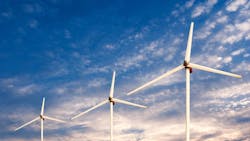Global Wind Operations and Maintenance Market Set for Strong Growth to $17 Billion by 2020
The global wind Operations and Maintenance (O&M) is estimated to increase from $10 billion in 2015 to $17 billion by 2020, at a compound annual growth rate of 11.2%, according to research and consulting firm GlobalData.
The company's latest viewpoint states that technological developments have paved the way for more effective and reliable equipment and machinery, making wind one of the fastest-growing energy sources in the global market. The exponential growth of the wind energy market is fueled by depleting fossil fuel reserves, the declining cost of wind energy generation, and a growing sensitivity for the environment, supported by financial incentives by various governments across the world.
Ankit Mathur, GlobalData's Practice Head for Power, explains: "The O&M of a wind farm is essential as it contributes to value creation, increases turbine availability - lowering downtime - and increases returns. Regular O&M reduces the downtime of a turbine and optimizes electricity generation, which results in an increase in revenue." Drivers of the market include advancing technologies, increasing demand for wind power, and innovation in components and predictive maintenance.
Mathur continues: "Advanced connected technologies such as the Internet of Things (IoT) will enable a much more effective and efficient evaluation of wind turbines along with its associated components. The IoT platform, through its collective and predictive analytics, can alert a service provider to any machinery problems in advance and to stay away from any crucial issues."
"Technological improvements and innovations will also help to drive down wind O&M costs. Direct drive technology and tension control measurement technology for turbine bolts are considered among the innovations that significantly decrease such costs. Direct drive technology works by eliminating the gearbox, which is one of the major areas of failure in a turbine."
"Tension control measurement works by minimizing bolted joint failures caused by insufficient bolt tension in wind installations. Although nuts and bolts are simple devices, their failure can be costly."

